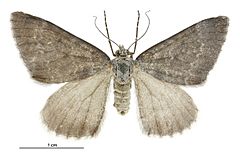Helastia clandestina facts for kids
Quick facts for kids Helastia clandestina |
|
|---|---|
 |
|
| Female | |
 |
|
| Male | |
| Scientific classification | |
| Kingdom: | |
| Phylum: | |
| Subphylum: | |
| Class: | |
| Order: | |
| Family: | |
| Genus: |
Helastia
|
| Species: |
H. clandestina
|
| Binomial name | |
| Helastia clandestina (Philpott, 1921)
|
|
| Synonyms | |
|
|
Helastia clandestina is a moth of the family Geometridae. This species is endemic to New Zealand. It is classified as "At Risk, Relict'" by the Department of Conservation.
Contents
Taxonomy
This species was first described by Alfred Philpott in 1921 using a specimen collected by E.S. Gourlay at Arthur's Pass and named Xanthorhoe clandestina. George Hudson discussed and illustrated this species in his 1928 book The Butterflies and Moths of New Zealand under the same name. In 1987 Robin C. Craw placed this species within the genus Helastia. The holotype specimen is held at the Canterbury Museum.
Description
Philpott described the species as follows:
♂︎. 35 mm. Head and palpi grey-whitish. Eyes olive-brown. Antennae dark grey, pectinations 5 but appearing shorter owing to being basally appressed to the shaft. Thorax grey. Abdomen whitish-grey. Fore-wings elongate-triangular, costa sinuate, apex bluntly pointed, termen straight, oblique ; bluish-grey ; lines faintly indicated in darker ; an irregular basal line at 1⁄6 ; first line at 1⁄3, double, slightly waved ; discal spot rather elongate, transverse, dark ; a fairly straight, slightly waved, median line ; second line from 2⁄3 costa to 3⁄4 dorsum, excurved on upper half, faintly margined with white on veins : cilia white, basally mixed with grey. Hindwings grey, slightly darker round termen : cilia white.
Distribution
This species is endemic to New Zealand. It occurs in Westland, North Canterbury and Mid Canterbury.
Biology and lifecycle
Very little is known about the biology of H. clandestina. Hudson records it being on the wing in February.
Host species and habitat
The host species for the larvae of H. clandestina is unknown. H. clandestina prefers stony riverbed habitat such as at the Waimakariri River flood plain.
Conservation status
This moth is classified under the New Zealand Threat Classification system as being "At Risk, Relict".

